The holiday season is rolling around as I write this, and like every year, garden centers and stores are full of colorful Christmas cacti, a type of succulent that gets its name from the time of year it blooms.
If you bring one home or receive one over the holidays, don’t throw it away once it finishes blooming! A Christmas cactus can bloom and brighten your home during the darkest months year after year.
Keep reading for everything you need to know about caring for a Christmas cactus plant indoors after it blooms.
| Common Name(s) | Christmas cactus, holiday cactus, crab cactus |
| Scientific Name | Schlumbergera x buckleyi, sometimes also Schlumbergera truncata |
| Family | Cactaceae |
| Height and Spread | Shrubby, up to 24 inches tall and 3+ feet wide |
| Light | Bright indirect |
| Soil Type | Bromeliad soil |
| Water | Keep lightly moist |
Disclosure: If you shop from my article or make a purchase through one of my links, I may receive commissions on some of the products I recommend.
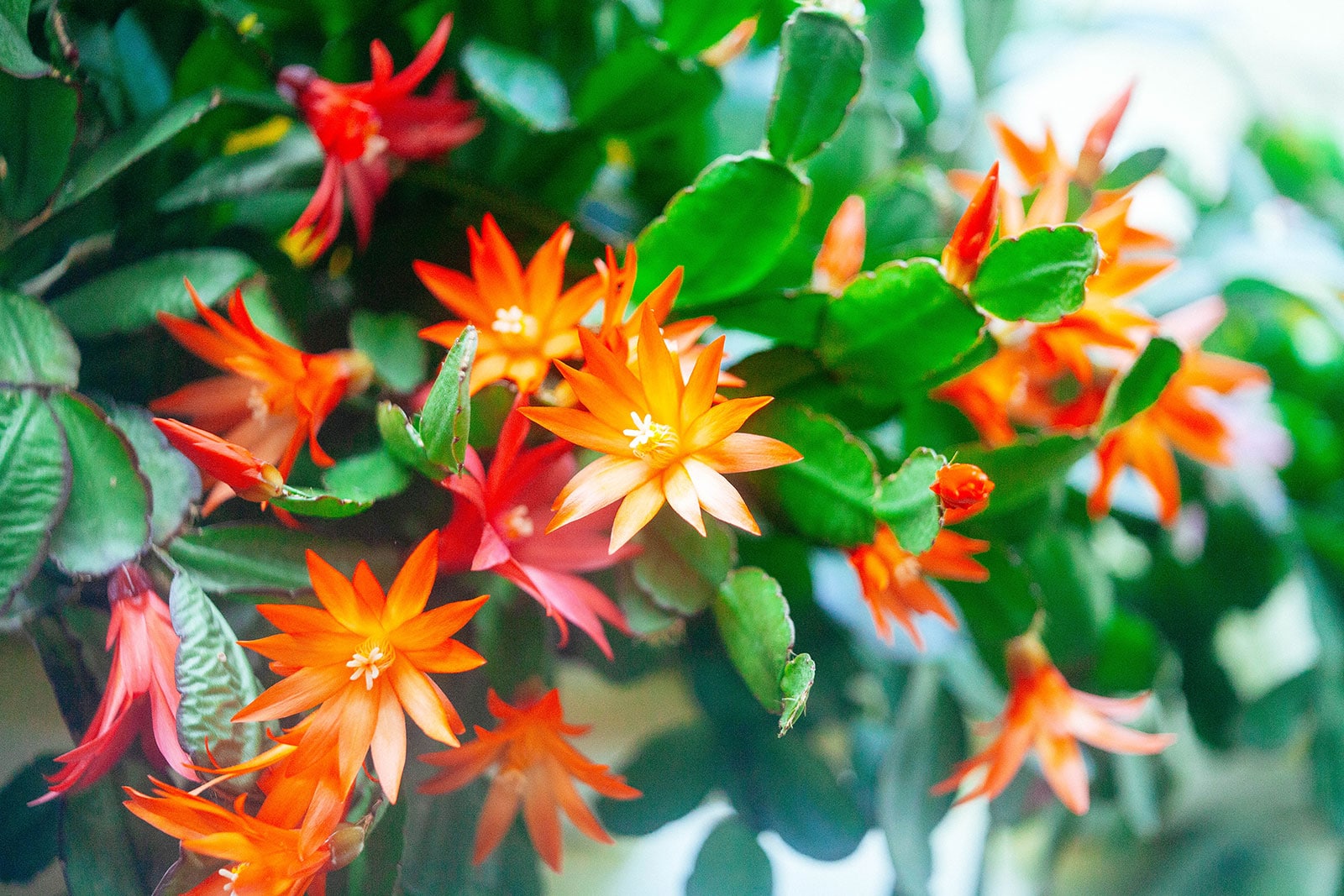
About Christmas cacti
Natural habitat
Strictly technically speaking, Christmas cacti don’t have a natural habitat. They’re a hybrid species resulting from crosses between two members of the same genus: Schlumbergera truncata (Thanksgiving cactus) and russelliana.
So where do these parent species naturally hail from?
Both are jungle cacti (or tropical cacti), meaning they don’t occur in the arid habitats many of their other cactus cousins do. They’re originally found in the same small area in tropical southeastern Brazil, where they grow in moist, high-altitude forests, soaking up the humidity, dappled sunlight, and balmy temperatures.
(While “moisture” and “cactus” might sound like an unlikely pair, jungle cacti are not unusual; they’re perennial favorites as houseplants and include coral cactus and fishbone cactus.)
As epiphytes, Christmas cacti naturally grow on trees in a non-parasitic manner similar to other epiphytes like string of turtles, air plants, and arrowhead plants.
Description
Christmas cacti are what’s often referred to as Zygocacti in horticulture and are members of the tribe Rhipsalideae. They’re epiphytic succulents that grow on trees and are easy to recognize from their growth pattern.
The plants don’t have true leaves; instead, they produce flattened, green stem segments (called cladodes, phylloclades, or simply “clades”) that look like long trailing leaves and are used to photosynthesize.
There’s really no mistaking a Christmas cactus’ flowers for anything else: they’re spectacular! Growing on the end of the segmented stems, the tubular flowers are triggered to open by short days and long nights, meaning they start blooming around the holiday season (and can bloom again in late winter, given the right conditions).
(Christmas cacti aren’t the only beautiful bloomers, by the way; many other flowering cactus varieties offer a stunning show as well.)
Read more: Bored with poinsettias? Here are 10 other holiday houseplants you can try
Selective cultivation has led to a very wide range of amazing flower colors like classic red and pink, but also yellow, orange, white, and multicolored.
Cultural significance and lifespan
This is definitely a plant with strong cultural significance. It’s a popular houseplant that’s used not just in the US but throughout the northern hemisphere to brighten up homes during the holiday period in November and December.
Did you know?
In its native Brazil, in the southern hemisphere, this plant is known as “flor de maio.” This is because it blooms there when winter is around the corner in May, rather than in December!
The plants are readily available beginning in mid-fall, sold at low prices when they’re in bloom and commonly discarded once they finish flowering. Many people treat Christmas cactus like Christmas poinsettia and amaryllis bulbs: as a one-time holiday houseplant.
But a Christmas cactus can be kept as a houseplant year-round, and given good care, it’s a long-lasting succulent that can easily live for 20 to 30 years—even up to 100 years or more!
Can you imagine passing a houseplant down to your children or grandchildren as a living heirloom? Or inheriting a Christmas cactus so old that it’s the matriarch of the family? (I love geeking out on things like that!)
Plus, you don’t have to worry too much about handing down your beloved plant to your next of kin. Other than a bit of special attention to encourage repeat blooming in fall and winter, a Christmas cactus is fairly easy to care for.
(Note that your Christmas cactus can still be perfectly healthy even if it doesn’t bloom every year.)
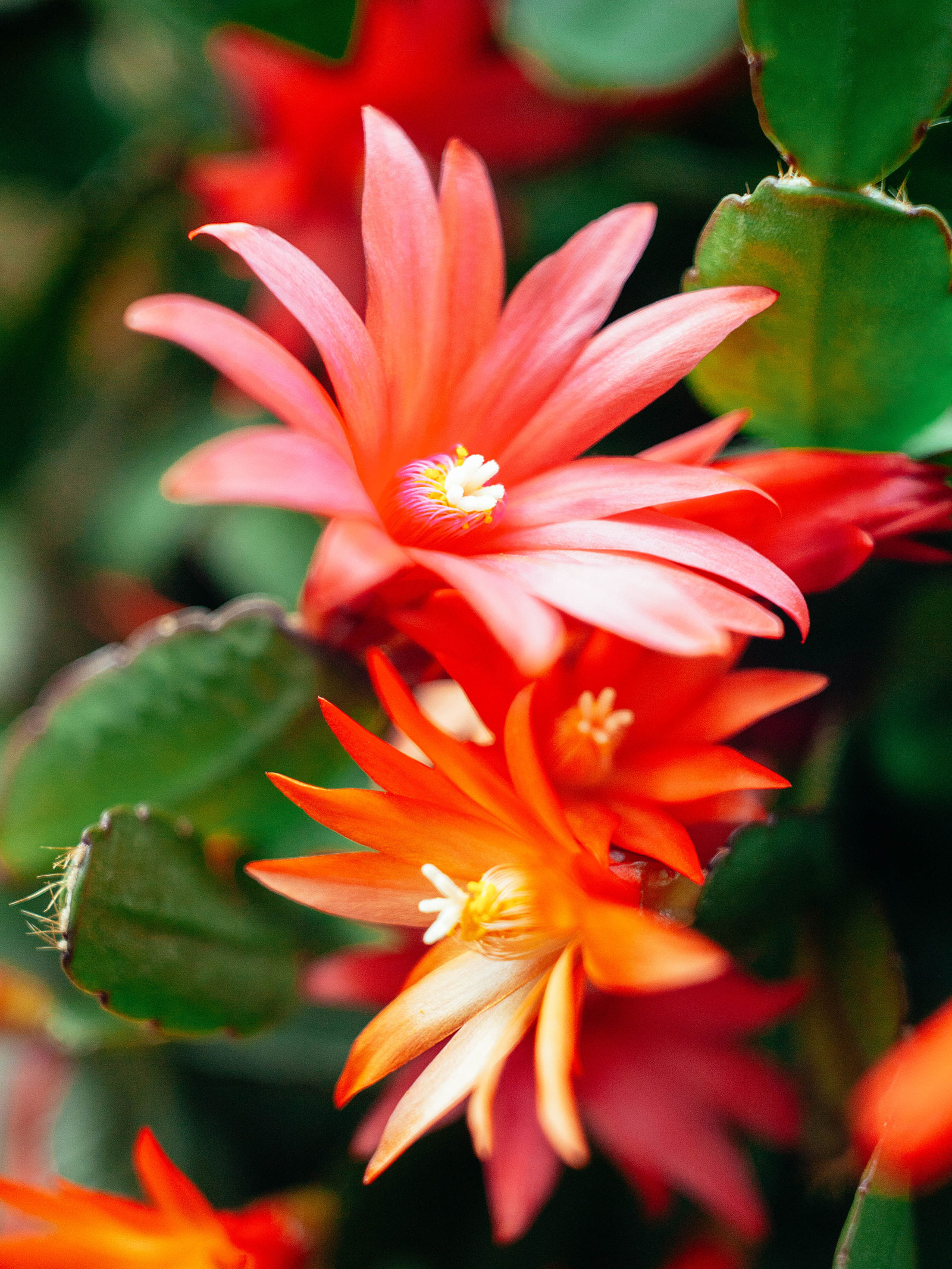
Christmas cactus varieties
As mentioned, the “real” Christmas cactus is a hybrid plant scientifically known as Schlumbergera x buckleyi. As I’ll discuss below, though, there are a few similar species that might be referred to by the same name.
Because of its status as a hybrid, there’s a lot of variety within Christmas cacti. Some may resemble one or the other parent plant more, without being listed as a specific cultivar.
Related: A layman’s guide to plant taxonomy (cultivars, varieties, hybrids and more)
And then there are the flowers: selective breeding has produced an endless amount of different colors!
I’m not even going to try to list them, but you could have a look at this page by the University of Massachusetts to get acquainted with a few.
This being said, the specific cultivar is usually not listed on the plants for sale at your local store, making identification a guessing game in most cases.
Where to buy
Christmas cactus vs. Thanksgiving cactus vs. Easter cactus
The name “Christmas cactus” is loosely applied to a number of similar jungle cacti.
What’s most important to know is that there are three main holiday cactus types. Each is now a member of the genus Schlumbergera, although they’ve been placed in and removed from quite a few different genera over the years.
Here’s how you tell the holiday cactus types apart:
- True Christmas cactus, or Schlumbergera x buckleyi: A hybrid holiday cactus that blooms relatively late. It can be recognized from its scalloped leaf segments and tubular flowers.
- Thanksgiving cactus, or Schlumbergera truncata: Often called a Christmas cactus and confusingly labeled as such in stores, even though it’s not the same species. It blooms a bit earlier and has more pointy leaf segments.
- Easter cactus, or Schlumbergera gaertneri (Hatiora gaertneri until very recently): As the name suggests, this variety blooms in spring, not winter. It’s not too difficult to tell apart from the other two, as its flowers have a rather “spiky” look and the leaf segments are more rounded.
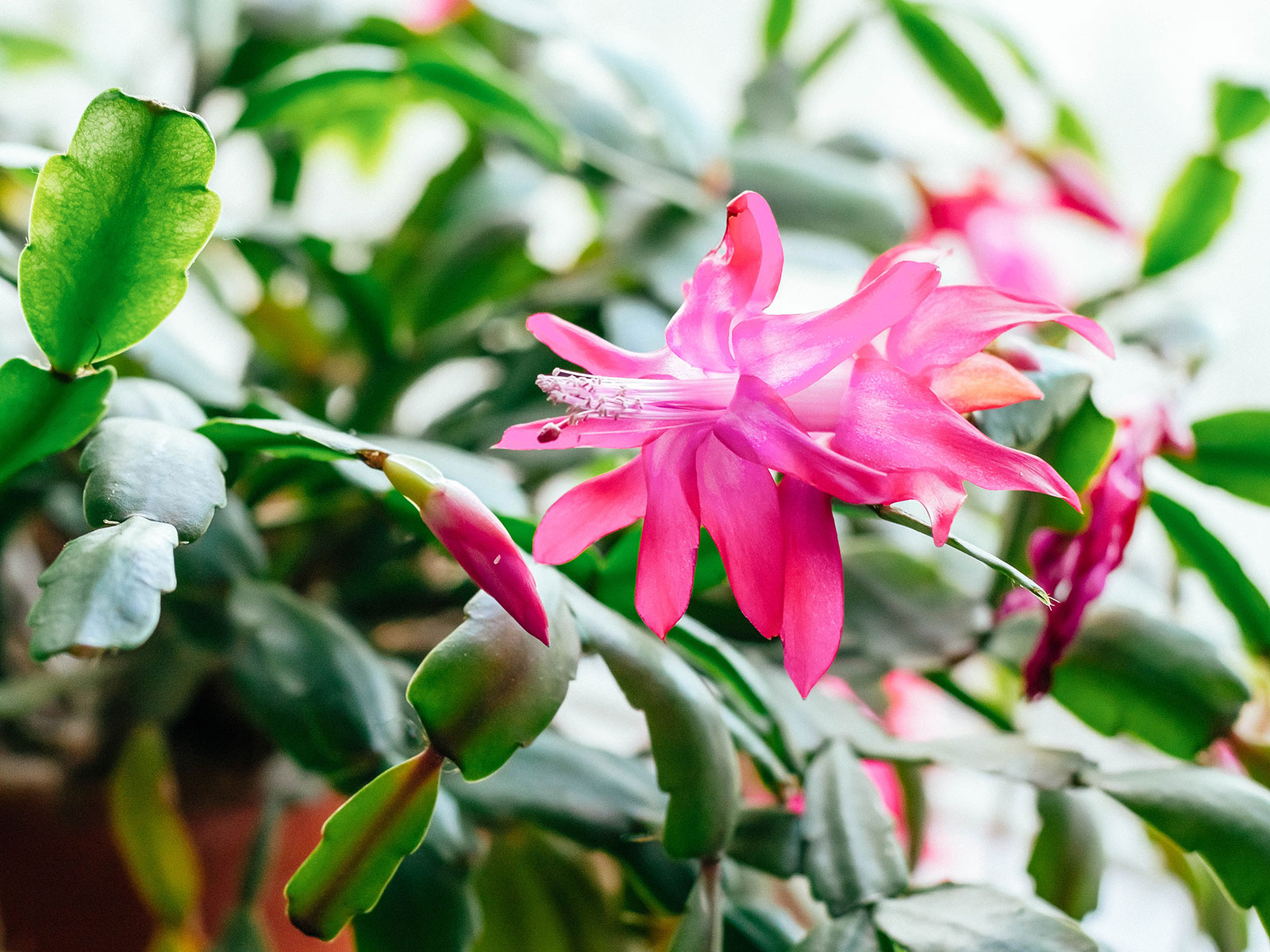
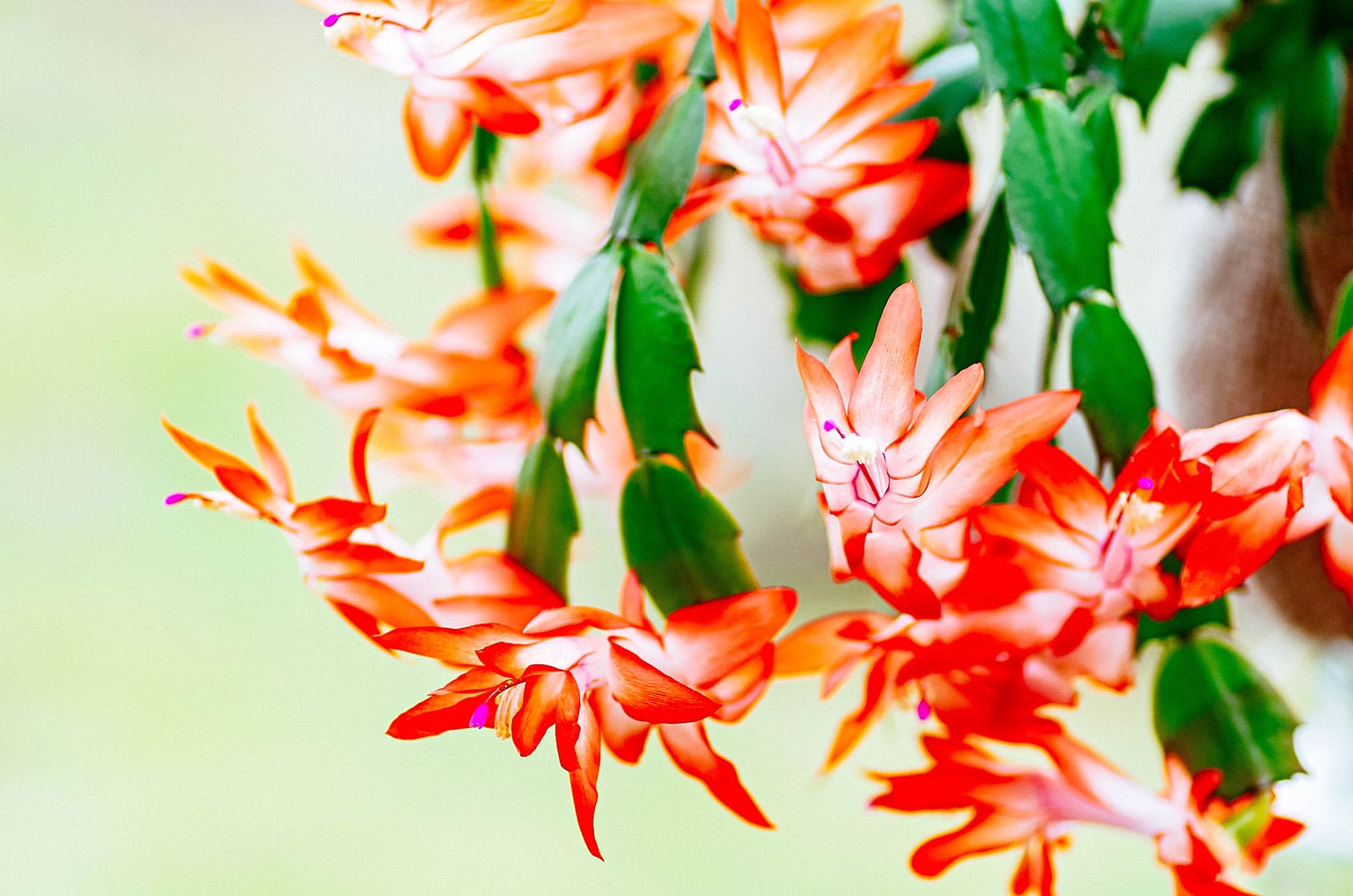
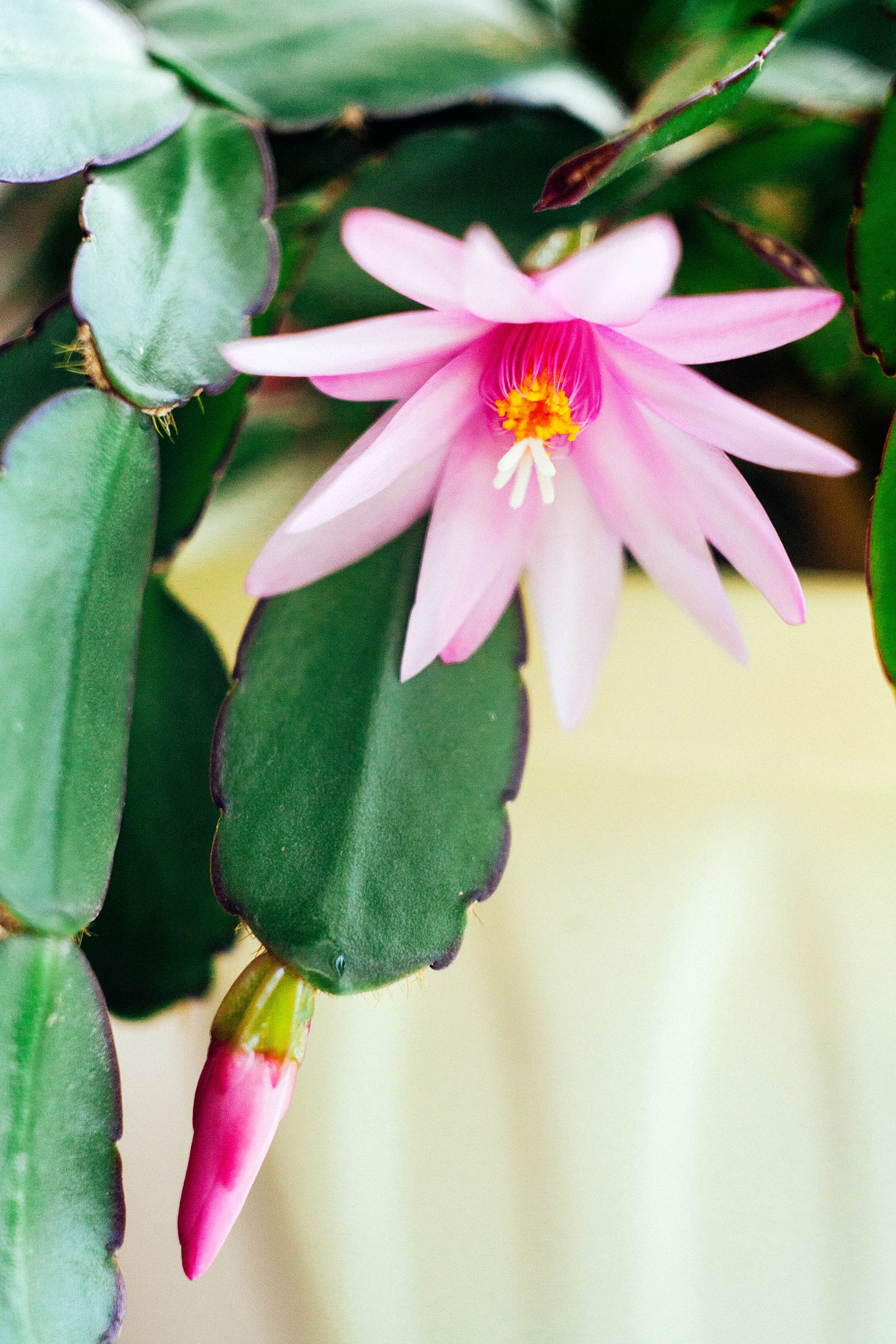
Caring for a Christmas cactus
Jungle cacti like the Christmas cactus are sometimes considered difficult to care for, but they’re actually not too challenging.
The problem is that folks tend to treat them like “regular” cacti, but as we’ve seen, they don’t come from arid habitats. They’re a tropical forest species, meaning they like a bit more water and less harsh sun than their desert cousins.
Light and temperature
Although some morning or late afternoon sun is perfectly fine and probably preferred, your Christmas cactus doesn’t need the intense light that desert cacti do. It likes a bright spot on a windowsill, but indirect light is mostly the way to go.
If you do expose your Christmas cactus to direct sun, it might start showing what’s referred to as stress coloration. This can be a bit alarming, as the leaves turn a dark, brownish red from their normal green color.
It’s not necessarily problematic, though, just something succulents do to protect themselves when they’re exposed to a lot of light.
Although they do need somewhat lower temperatures during late fall in order to bloom successfully (I’ll describe that below), it’s important to keep in mind that Schlumbergera is a genus from the tropics that doesn’t like cold.
Normal room temperature is perfect, although a bit hotter won’t be a problem either. Just try not to let things drop below 50°F.
Water and humidity
Although they do have the capacity to store some water in their fleshy leaf segments, Christmas cacti aren’t quite as efficient at this as their desert cousins.
Don’t let yours go without for too long, or it might turn wrinkly and even start dropping foliage.
Keep your Christmas cactus’ soil lightly moist from the start of the growing season in spring through to when the blooming period ends. After that, you can let the soil dry out a bit more, though make sure it never goes bone dry.
You’ll probably be watering about twice a week during summer if your cactus is in a well-lit spot, while in winter it may only need a sip every week and a half or so.
Christmas cacti do like a bit of humidity, which isn’t surprising for a tropical. If your home is on the dry side, running a humidifier can be helpful for both you and your houseplants.
Soil and planting
Christmas cacti really aren’t too fussy when it comes to soil, although it’s a good idea to keep in mind that they’re naturally epiphytes that grow on trees rather than in soil. They like a mixture that’s relatively loose, but does retain some water.
They do great in Bromeliad soil, which makes sense, as Bromeliads are epiphytes as well. Sometimes you’ll find this type of potting soil called “orchid soil” or “orchid potting mix,” and it works perfectly well for Christmas cactus.
Both like a relatively acidic soil mixture with gritty material that allows excess water to drain, but also some peat to maintain a bit of moisture.
For my own Christmas cacti, I’ve always kept it very simple by just mixing a normal houseplant potting soil with about 30 percent perlite. They’ve never seemed to mind!
If you need better drainage, you can toss in some more perlite or orchid bark. If the soil drains too quickly, add some coco coir or peat moss instead.
When it comes to planters, as long as it has a drainage hole in the bottom, you’re golden. Terracotta is a good option for those who tend to water too much, as it allows the soil to dry out more quickly. Plastic is better if you’re worried you may underwater.
For larger Christmas cacti, a hanging planter can be a great option, as the stems tend to start hanging down as they grow.
Recommended
Plant care products
Fertilizing
Christmas cacti aren’t very heavy feeders, but that doesn’t mean they don’t appreciate a little boost once in a while.
You can fertilize yours once a month or so during the growing season (from early spring through late summer), but make sure to stop once you see the buds start to form in fall. There’s no need to fertilize in winter since the plant isn’t actively growing.
A diluted liquid houseplant fertilizer should be perfect. Or, you can use succulent and cacti plant food that’s formulated for potted plants.
Recommended
Fertilizers
Pruning
I’ve never pruned any of my Christmas cacti: the longer their stems get, the better they look to me. If you do want to shorten them at any point, it couldn’t be easier, as you can simply pinch the segments loose. Just don’t do this if your plant is budding or blooming!
If you do decide to prune your Christmas cactus, be sure to have a look at the section on propagation (more on that below) to see how you can regrow the cuttings.
Dividing or repotting
This species doesn’t need a large planter and you probably won’t have to repot yours to a new home all too often—it actually likes being a little crowded.
If you notice the soil has started to dry out too quickly, though, this can be a sign your Christmas cactus is very root-bound. You may need to go one pot size up come springtime.
If it’s not time to repot yet but it’s been a year or two since your Christmas cactus last received fresh soil, it might appreciate being taken out of its planter for a refresher.
You can also easily divide the plant at this time, as one specimen is often made up of multiple loose stems potted together.
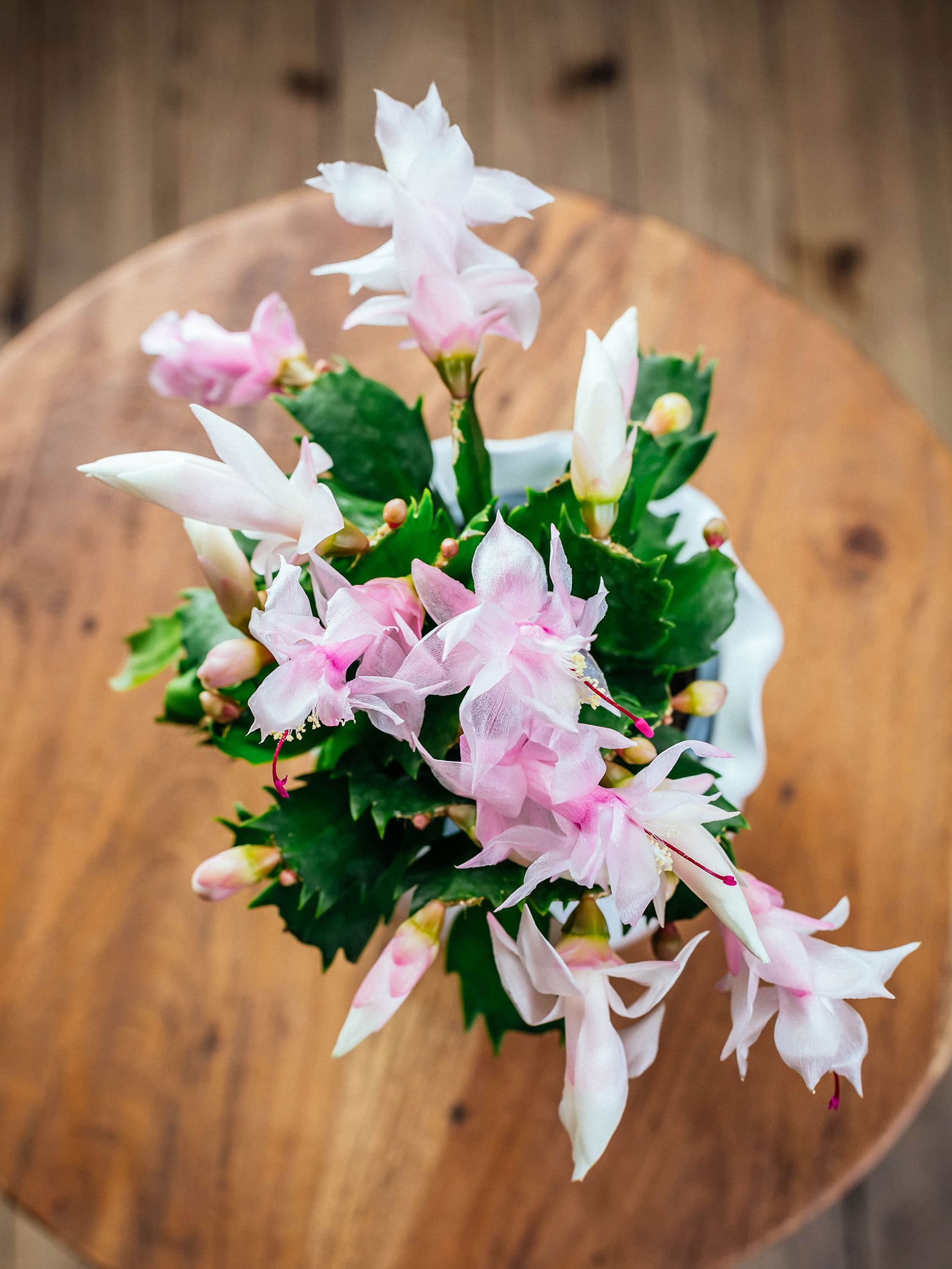
Propagating a Christmas cactus
Because it’s so easy to pinch a few segments off your Christmas cactus, and they can technically regrow from a single leaf, you can imagine that propagating these plants isn’t exactly a challenge.
If you’d like to multiply your Christmas cactus, just take sections consisting of a few segments and plop them straight into soil. They can be rooted in water, but they take so easily in soil that there’s really no need.
If you want to create new Christmas cactus plants, you can place three to four cuttings in a small new pot. Mist the soil regularly for a month or so and then give the cuttings a slight tug. If you feel any resistance, that means they’ve rooted and can be switched to a normal watering schedule.
You can also place cuttings back into the mother plant’s pot for a fuller look.
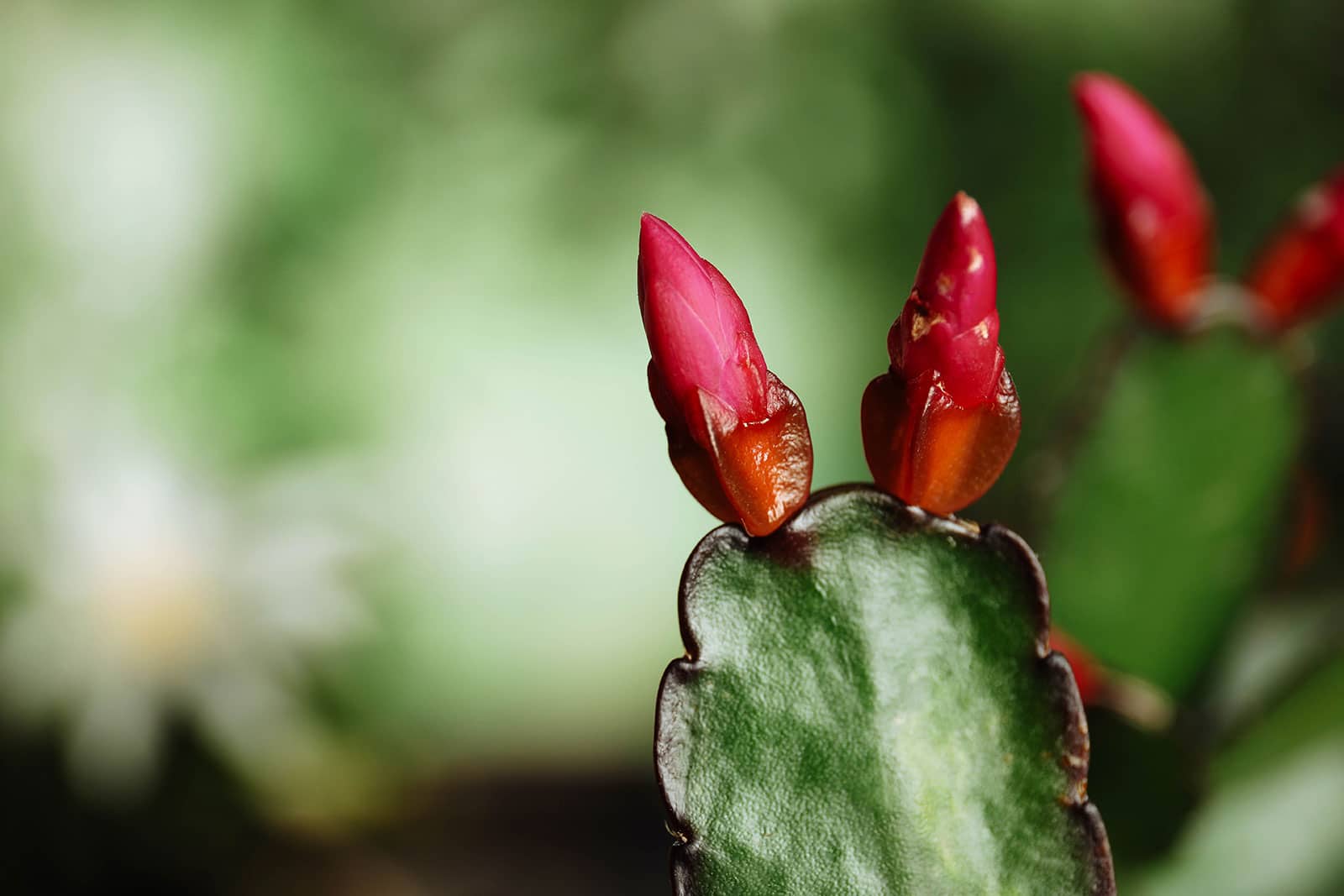
How do you make a Christmas cactus bloom?
Isn’t that the million-dollar question! If your Christmas cactus made it a full year after purchase (congrats!), you’re probably wondering how to make sure it blooms as wonderfully as when you bought it.
The main thing to keep in mind is that fall and winter conditions trigger flowering in these plants, so you need to imitate that environment indoors to stimulate bud formation in your Christmas cactus.
A punishing routine of minimal watering, increased darkness, cooler temperatures, and no fertilizer will drive your plant to burst in a brilliant display of flowers in fall and winter.
Your Christmas cactus might bloom with no intervention at all on your part, but here are some things you can do to ensure abundant flowering:
- Reduce temperature. Although Christmas cacti don’t like being too cold, temperatures around 60°F starting late October can help kickstart things.
- Reduce light. The days are naturally shorter during winter, but in the home, we often leave the lights on until late. You can place your Christmas cactus in a space where it stays dark after the sun goes down. Some houseplant enthusiasts even put theirs in a closet at night.
- Reduce water. In the section on watering, I mentioned these plants like to stay lightly moist until they finish blooming. There’s a little exception: during the bud formation period, it can be helpful to let the top layer of the soil dry out.
As you may have gathered, something like a garage or shed can be the ideal spot for your Christmas cactus during these few weeks. Once you’re happy with the amount of buds, you can move your plant back to its normal position in the home.
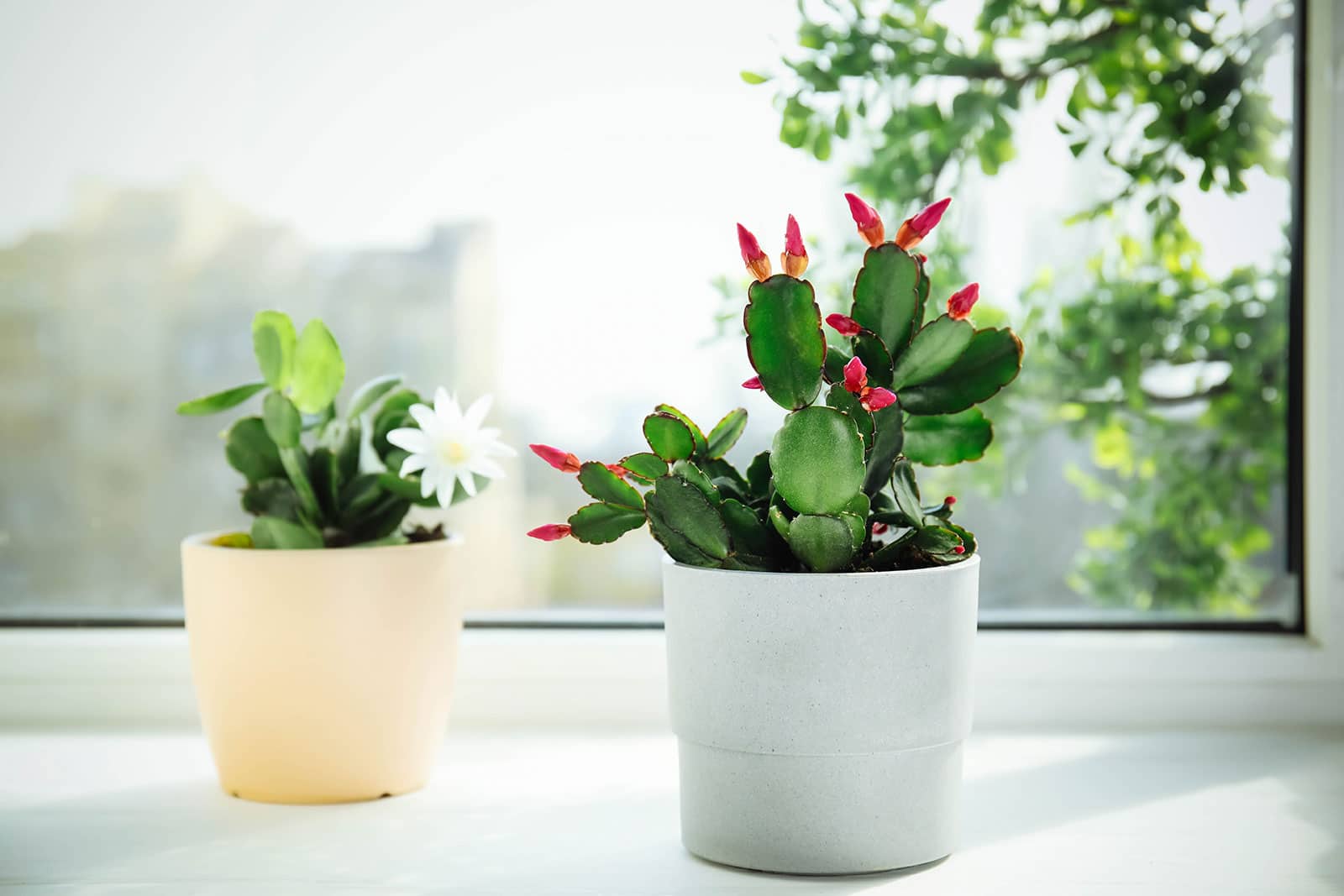
Frequently asked questions
Sources
- McMillan, A. J. S., & Horobin, J. F. (1995). Christmas cacti: the genus Schlumbergera and its hybrids (Vol. 4). D. Hunt.


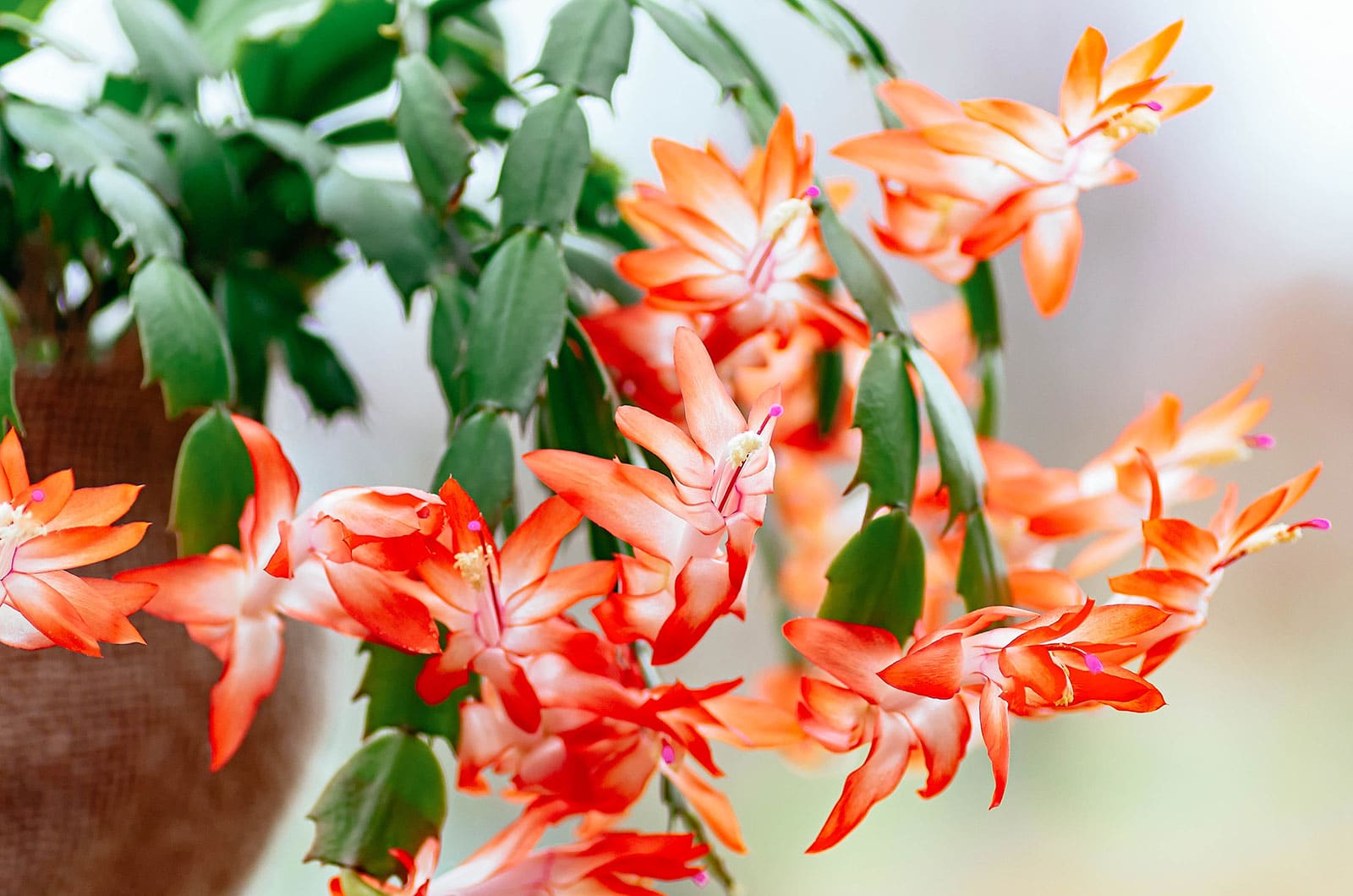













Hi Linda,
I have a beautiful brilliant orange flowering Easter cactus. I’ve read your entire article on Christmas cactus hoping to find information for care of the Easter cactus. I can not find any specific advice for the Easter cactus blooming tips. Any advice is greatly appreciated.
Thank you,
Christine
I have a beast of a cactus that was gifted to me three years ago. The soil is a rock hard lump inside a terracotta planter. I water it once a week or so and it’s in a back room with indirect bright light and it’s utterly thriving, so I haven’t done a thing to it since I got it! It blooms three times per winter (so far). I’m waiting to see signs of stress, but until then, it’s happy and I’m happy.
I have had luck with placing pots of Christmas Cactis under brushes and let them poke out just a little bit. is also a good way to propagate new places. it allows them to get some filter sunlight but not get too hot from the North East Florida sun. the good Lord waters them and I only water when it is especially dry. some of the pits have been in the ground for a number of years. I just need to put in an oversized pot or remember to repot when they get too big for their pot. p.s. the love banana peels so put a few in the bottom when potting or give places as a treat under the soil every few week. love your site!
My mother instilled a love of gardening and nature in me, beginning in my young childhood. I was able to soak in her green thumb outdoors, but never had luck with indoor plants–my brother got that gift from her…I found such joy ‘living with’ a jade plant she kept thriving for 40 years! She will be 93 this New Years Day–a present for her–and for me–will be another Christmas Cactus (for she can make them thrive all year)! I have been able to keep a small cactus from my brother alive for over 30 years–in spite of myself…), but now I will take hold of your suggestions and carry on my mother’s legacy! Thank you for your post!
That’s so wonderful—and 30 years is impressive!
my Christmas cactus has been passed down from my grandad and is now between 40 to 50 years old. it didn’t flower for years whilst my mum owned it, now it is mine it blooms every year. it’s a wonderful thing to inherit.
my cacti love being outside on the patio: they flourish from spring through fal. Louisiana summers are hot! It’s 10 October and we’re in the low 80s by day and upper 50s to 60s by night .
I will bring them i when the nights get lower than 50!! Thank you for writing this article!!
Carol
Hello Dianne, I have a Christmas cactus that I got over 40 years ago. I put her in the hallway upstairs, surrounded with a dark sheet. I did it just today and will leave her there til about the 15th of November.
I have even named her.. Patty
Good luck! Linda
I too am a believer with first hand experience. My sister and I all have plants that came from cuttings off our grandmothers plant and it belonged to her mother so it is already at least 100 years old!
my christmas cactus was overwatered while on vacation for 2- 1/2 weeks. by the time we returned, it had already started to yellow. Its bloomed twice since then, but no perceptible change in color. should i cut it back or pray?
I saved a christmas cactus. The tips are bright green but the rest of it is scaled and pale. Should I just replant the tips? Thanks
Hi Stephanie, my husband gave me a beautiful full blooming red cactus for my November birthday. I would like to follow your recommendation to keep the cactus in the dark for 12-24 hours after it stops blooming. I am wondering if it stays in the dark or does it need to have light at all, like during the day? Also, while it is somewhat dormant does it need any water? My thoughts about your suggestions are 1. after blooms are finished, I put the plant in my dark and cool storeroom. 2. Then I leave it there until it starts to bloom again. 3. During this time, I take it out of the storeroom and let it have some light, 4. Then I lightly water it every week to ten days. How long does this process usually take and does it still need a bit of water and that is all? You mentioned I might see it bloom again in February, so a couple of months in the dark? If I plan to leave it in the storeroom darkness for 24 hours and never take it out, does it still need a bit of water? I admit to some confusion about the best way to keep my cactus alive and blooming through the winter. Thanks for reading all of this. I love my gift and want to do whatever I can for its overall health. Dianne
Read the whole Christmas cactus article and enjoy the super way ‘Garden Betty’ has covered your question. This is a very well researched and written site from a generous lady who genuinely shares her life with us all. One to bookmark.
Bob Lawson Curator, Ferniehirst Castle Jedburgh Scotland
Hello Dianne, I have a Christmas cactus that I got over 40 years ago. I put her in the hallway upstairs, surrounded with a dark sheet. I did it just today and will leave her there til about the 15th of November.
I have even named her.. Patty
Good luck! Linda
True believer here!! I have a Christmas cactus that I’ve been caring for, that’s moved with me over the years and continues to bloom year after year – I want to say for at least 28 – maybe 30 – years. I take it outside (along with most all of my house plants) in the spring and summer, and bring it back inside for the fall and winter. I’m in the SE part of PA, zone 6b. They are very hardy, forgiving plants. It’s a steadfast friend. 🙂 Great article, Linda! Thanks! Cheers to many more years of friendly plants!!
I have a pothos that’s 27 years old and going strong, right now it has a couple 12 foot long strings roaming around my back room. Every once in a while I give it a big haircut and put some cuttings in water, it must have 20+ babies by now off in the world. I basically ignore it until some of the leaves start to go brown, then I soak it in the sink for an hour or so, once every couple months.